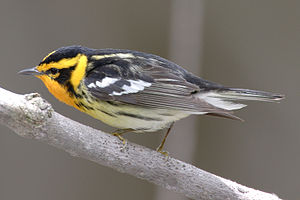Spruce Warbler
| Spruce Warbler | ||||||||||||
|---|---|---|---|---|---|---|---|---|---|---|---|---|

Male warbler ( Setophaga fusca ) |
||||||||||||
| Systematics | ||||||||||||
|
||||||||||||
| Scientific name | ||||||||||||
| Setophaga fusca | ||||||||||||
| ( Statius Müller , 1776) |
The spruce warbler ( Setophaga fusca , syn .: Dendroica fusca ) is a small bird from the genus of the tree warbler ( Setophaga ) in the family of the wood warbler (Parulidae). The English name "Blackburnian Warbler" goes back to the English botanist Anna Blackburne .
features
The plumage on the head, throat and chest area is bright orange. The dorsal plumage and the wing covers are gray-black to gray-brown with white spots on the wings. The underside plumage has a yellowish color with black stripes on the flanks. In contrast to the male, the female is duller in color and has a duller orange on the head and chest. The young birds have a plumage similar to that of the adult females.
nutrition
The food of the spruce warbler consists mainly of insects . In winter he expands his menu to include berries and fruits . It is important for the North American forests in the north, as it mainly kills pests and the caterpillars of harmful insects.
Occurrence
The breeding areas are in the east of North America , from southern Canada over the Great Lakes and New England to North Carolina . The spruce warbler migrates to the Andes to spend the winter in South America , Colombia , Ecuador and Peru . Other areas are in Venezuela and Panama , where, however, a smaller number of spruce warblers can be found than in the other areas. It is also a rare guest in Western Europe .
literature
- Jon Curson, David Quinn, David Beadle: New World Warblers. Helm, London 1994, ISBN 0-7136-3932-6 .
Web links
- Setophaga fusca in the endangered Red List species the IUCN 2008. Posted by: BirdLife International, 2008. Accessed on December 23 of 2008.
- Videos, photos and sound recordings of Setophaga fusca in the Internet Bird Collection